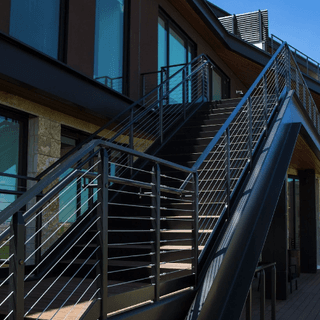Modern cable stair railing systems offer a minimalist design solution for stairs, deck, balconies, and ramps. Their modern aesthetic can complement contemporary projects or act as a contrast to more traditional designs. In this ultimate guide to stair cable railing systems, we’ll walk you through the different types of cable railings and the materials that they’re available in as well as break down the pros and cons of including them as part of your project.
What Are Cable Stair Railings?
Cable stair railing systems use a series of metal posts to support lines of cables that are under tension. Tensioners located at strategic points on the railing hold the cable taut as it passes through the posts and acts as the infill in between them. While many stair railing cable systems feature horizontal cables, another option is a vertical cable stair railing with vertical rails that run between the top and bottom posts.
Cable stair railings are available as customized railing systems that require professional installation, but can also come as a stair cable railing kit with do-it-yourself installation.
Cable Stair Railing Materials
Cable wire stair railing materials are typically stainless steel, but they are also available in aluminum. Stainless steel, however, is available in three different grades: 201, 304, and 316.
The different grades of stainless steel for metal cable stair railings are based on their nickel content. Less nickel means that it’s more susceptible to corrosion and vice versa.
Type 201 has the lowest nickel content and is therefore the most susceptible to corrosion, so it should be used in indoor applications. Type 304 and 316 have higher nickel content and are less likely to rust, which makes them better suited to outdoor applications, but it also means that they’re more expensive.
Pros of Cable Stair Railings
Cable stair railings are a modern and versatile option for a wide variety of applications and they provide many benefits:
They have a clean and modern aesthetic.
They are highly durable and don’t require much maintenance.
The posts and railings can be powder coated to match the surrounding design.
Cable railings can be installed by do-it-yourselfers and professionals.
Cons of Cable Stair Railings
While cable stair railings are very versatile and work in many different applications, they also have their limitations and drawbacks.
They can’t create a truly curved configuration.
While the gap between the railings meets building code requirements where allowed, it may not be ideal for environments that serve small children.
Horizontal cable stair railings may be prohibited in some municipality building codes.
Cable Stair Railing Ideas for Your Project
Our stainless cable stair railing systems offer versatility and durability for interior and exterior applications. You can also customize our systems to fit the needs of your project. Customizations include powder coating, handrail profile, and mounting options.
These cable wire stair railing ideas will help you envision how to integrate VIVA railings into your design.
Use Powder Coated Railings
At the PGA Headquarters in Frisco, TX, they utilized our posts that are powder coated black and our stainless steel cables to match the aesthetic of the building and blend right in while also acting as a design feature along the stairs and the balcony. The CUBE™ Cable Metal Railing System features a 2”x1” rectangular top post and a tubular handrail to meet building code requirements for metal and cable stair railings.
Create a Soft Curve
While cable railings can’t create a truly curved railing because the cable itself will be straight in between the posts, you can create a softly curved railing that allows the cable to create the illusion that it’s curved. Including a curved top rail and tubular posts also serve to soften the appearance. This elevated walkway at the Lentz Public Health Center in Nashville, TN employs the VIVA CIRCA® Cable Railing System to do just that.
Mix Materials
For this cable wire stair railing at the UT Dell Medical School Administration Building, in Austin, TX the CUBE™ Cable Metal Railing System is paired with a rectangular wood top rail and ramp railing to bring cohesion between the metal of the cable stair railing system and the wood elements found throughout the room.
Make Stairwells Safer
Cable wire stair railings make the stairwell safer by providing a continuous railing from the top of the stairs to the bottom, and the cable infill also allows for increased visibility. Our CIRCA®Cable Railing System at the University of Nebraska-Kearney Science Education Building maintains a modern feel while also increasing safety.
Integrate Lighting
With our iRAIL™ system, you can integrate lighting into a modern stair railing cable for added safety and visibility at night. The elevated walkways at the BB&T Leadership Institute in Greensboro, NC use the iRAIL™ Linear system to guide users and light the rails and the walkway beneath them. Our lighted rails are also available as LED Pods and LED Capsule systems.
Choose VIVA Railings for Modern Stair Railing Cables and Systems
Our code compliant stainless steel cable stair railing systems offer a variety of post styles, top rail and handrail options, and integrated lighting. You can work with our in-house team of engineers and fabricators to create the ideal railing for your space from the concept to the final installation.
Contact the experts at VIVA Railings today to create the ideal steel cable stair railing to provide the ultimate safety and style!


